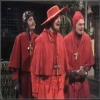 | Forum
Reply | Corny Joke Warning
at 08:29 4 Oct 2025
Make sure you catch a stunning new Netflix series in which a wealthy young man gradually attempts to fix the face of his metal fiancee.
It's called Bride's Head Re-Riveted |
 | Forum
Reply | Corny Joke Warning
at 14:54 29 Sep 2025
Christ, what a morning. On the way to the tube a clarinet tripped me up, then a violin hit me over the head whilst a nasty looking bassoon kicked me in the guts.
I'm not usually one for conspiracy theories, but this looks to me suspiciously like an orchestrated attack. |
 | Forum
Reply | Bircham isn’t happy
at 13:47 22 Sep 2025
Doing some work in Berlin over the weekend, and managed to find a bar showing Sky, with a Shedload (German:scheisseloade) of Liverpool 'Fans' watching.their game on multiple screens. A tiny screen in the corner.showed the QPR game, in front of which were no fewer than 4 guys, who naturally immediately welcomed me in and shared the next round.
When Liverpool scored, there were a few whoops from the assembled multitude.
But, when Vale scored that thing of beauty, five guys shouted a 'yeah' loud enough to get them all looking and wondering who are these nutters.
But here's the thing. As our madman was dancing around at the end, we did too, and it put such a smile on everyone's face that they're probably still talking about it.
Love him. [Post edited 22 Sep 13:51]
|
 | Forum
Reply | Best flight/service/food etc on a plane
at 09:52 16 Sep 2025
Travelled a lot to California back in the day, but since I hate long-haul flights I used to book via New York so I could break up the journey a bit. So, we were delayed out of LHR for some reason or other and missed the connection in NY, so had to wait in a long queue getting help booking a new flight to LA. Inevitably, there were people all around arguing with the agents and losing their rags - as if the poor sods could magically pull flights and seats out of their arses. When it was my turn, I joked with the agent about the mayhem as she tapped away and booked me a new flight. She then handed me over new tickets with a smile and the comment 'thanks for being so patient'. It was only when I got to the boarding gate that I realised she had put me in first class.
Just sometimes, a little politeness and patience is rewarded. |
 | Forum
Reply | Worst flight / service / food etc on a plane?
at 16:29 15 Sep 2025
Yup, much the same experience - plane struck by lightning coming into Chicago with much the same effect. Horrible combo of screams and vomit, the crunch as we (literally) hit the runway gave all the bones in my body a truly terrifying rattle.
Mind you, still less bad an experience than Wembley in 86, which I've never recovered from. [Post edited 15 Sep 16:31]
|
 | Forum
Reply | How about a few “not a lot of people know thats”
at 09:06 9 Sep 2025
Indeed - this also apples to common animals such as dogs & cats, and cows and bulls, who recognise blue and yellow but find it hard to see red or orange. So when you see a bull running towards a waving red cloth, it’s the waving movement, not the red colour that's attracting its attention. This also helps explain why most mammals support Qpr or Norwich. [Post edited 9 Sep 9:07]
|
 | Forum
Reply | Corny Joke Warning
at 09:31 6 Sep 2025
To compete in the Oxford & Cambridge boat race, do you need a scholar-ship? |
 | Forum
Reply | Squad numbers out
at 20:10 8 Aug 2025
This. If we're pinning all our hopes on developing young players so successfully that they can slip in the first team without a hitch then we're in serious trouble. |
 | Forum
Reply | Corny Joke Warning
at 12:39 26 Jul 2025
I told the doctor that everytime I walk from one country into another I have an overriding desire to get drunk.
He said I was borderline alcoholic |
 | Forum
Reply | Anthony Hayes
at 11:36 22 Jul 2025
His other brother, Hannibal, was quite a character |
 | Forum
Reply | The Saintly borough of Hammersmith & Fulham
at 12:20 17 Jul 2025
In Westminster, the rubbish gets collected around 6.30am on Mondays and Thursdays (my mum in Scunthorpe, who got her stuff collected every two weeks, always considered this an unbelievably great luxury) which means putting the stuff out at 6am or overnight. Lots of people do put it out overnight of course but I tend to avoid this 'cos of all the foxes, rats, pigeons and whatnnot we have around. BUT here's the thing. The one time I did, I got a warning letter from the Council threatening me with a fine. GRRR. |
 | Forum
Reply | If we were never born
at 10:31 17 Jul 2025
I didn't believe in reincarnation in my past life, and I still don't.
Woody Allen |
 | Forum
Reply | Things that annoy you in life .
at 09:24 22 Jun 2025
Another vote for pigeons - and Deliveroo drivers.
In my 'hood these two annoyances are connected as the Deliveroo people feed the bloody things (which are effectively rats with wings - collective noun a 'poop') whilst waiting to pick up stuff from the supermarket next door. No amount of me yelling and screaming seems to have any effect. Suggestions welcome, preferably of the legal variety. [Post edited 22 Jun 9:25]
|
|  | johann28
|
Site Scores| Prediction League: | 0 | | TOTAL: | 0 |
|